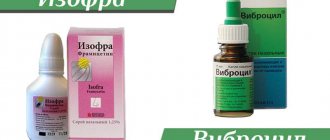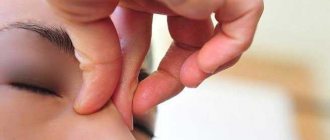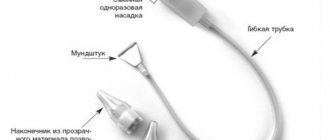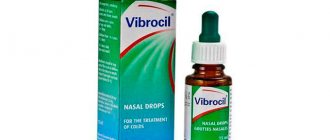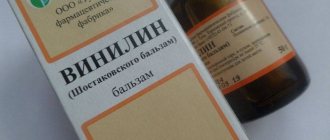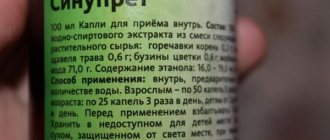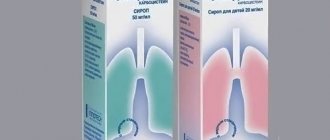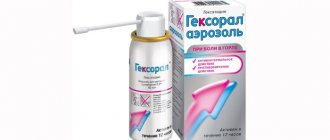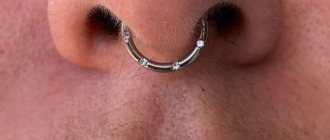To understand how to deal with green nasal mucus in children, you must first find out the root cause of its appearance. Most parents begin to worry even if their child develops a clear secretion, although such discharge does not pose a threat to his health. Another thing is the appearance of thick snot with green spots. This sign means that a bacterial infection has been added to the runny nose.
To eliminate unpleasant nasal discharge and congestion, treatment should begin immediately to avoid possible complications. Doctors quite often prescribe drops for green snot for children with a runny nose.
Causes of nasal discharge in babies
Green mucus indicates that microbes have joined the inflammatory process: Staphylococcus aureus or streptococci. This muconasal secretion often occurs at the end of a cold. You can understand that the child is recovering judging by the main symptoms - snot begins to easily come out of the nasal sinuses, there is little of it, the baby develops an appetite and overall well-being improves.
Sinusitis also causes a greenish tint to appear in a child. Inflammation of the mucous membrane of the paranasal sinuses is usually accompanied by congestion, high fever, night cough, purulent discharge, and headache.
With sinusitis, the following symptoms also appear:
- swelling of the gums;
- pain in the maxillary sinuses;
- pain in the back of the head and parietal part of the head (sphenoiditis);
- pain between the eyebrows (frontal sinusitis);
- unpleasant sensations in the bridge of the nose (ethmoiditis).
Green snot is also observed with rhinopharyngitis. If a runny nose is not treated, posterior rhinitis may occur. With this disease, muconasal secretion, flowing down the pharynx, irritates it, resulting in inflammation of the mucous membrane. In this case, a small patient develops pain and a burning sensation in the throat area, and the snot is difficult to wash out and blow his nose. In the morning and at night, a cough and runny nose begins to torment. This disease must be treated in order to prevent negative consequences for the child’s body.
How does Protargol work?
On the surface of the skin or mucous membranes damaged as a result of disease and inflammation, the drug Protargol forms a protective film (due to the precipitation of proteins with silver). Protargol reduces the sensitivity of the skin and mucous membranes, constricts blood vessels, which leads to the suppression of inflammatory reactions. Silver ions suppress the proliferation of various viruses and bacteria.
What does Protargol consist of?
The drug Protargol consists of proteins that contain silver ions (7-9%).
Why is green nasal discharge dangerous?
If nothing is done about such a runny nose, the disease will become chronic. Getting rid of advanced rhinitis is much more difficult. It is for this reason that when green nasal mucus is detected in a baby, especially in infants, treatment should be started as quickly as possible. Infants have low immunity and the nasal passages are very narrow because the nasal septum has not yet formed.
Drops for green snot in a child help to avoid many complications, because if no therapeutic measures are taken, frontal sinusitis or sinusitis will develop. Pathological data indicate that the inflammation began to spread upward. A stuffy nose sometimes causes meningitis in babies.
When the infection moves downward, the lungs and bronchi suffer. This is why thick green snot, accompanied by poor health and high fever, requires urgent treatment. It is necessary to visit or call a doctor at home; self-medication for such symptoms is unacceptable.
What drops can a child use for green snot?
Inflammation when bacteria enter the body provokes swelling of the nasal mucosa. Because of this, the little patient begins to accumulate thick green discharge all the time, which makes breathing difficult. After finding out the exact cause of their appearance, you can begin treatment. During the treatment of a runny nose, various measures are resorted to:
- washing;
- taking antibiotics (in complex and advanced cases);
- traditional medicine recipes.
In addition, sprays and drops from green snot are used for children. But before starting treatment, you should first thoroughly cleanse the nasal cavity of viscous secretions. In order for the baby's green mucus to come out naturally without stuffy ears, it is necessary to blow his nose correctly.
The handkerchief must be clean; it must be distributed over the hand. Then it is applied to the nasal sinuses, while the right nostril is pinched and a strong exhalation is made through the left. Then you should release the right nasal opening, close the left one and blow your nose.
What is protargol?
Protargol is a protein compound and is available in powder form with a silver percentage of 7.8 to 8.3%. In color it is a brown-yellow or brown powder with a faint bitter taste and no odor. To enable external use, public and private pharmacy chains prepare an aqueous solution based on it, thereby reducing the concentration to 1-5%.
Compared to antibiotic-based drugs, protargol does not disturb the natural microflora of the body, which is why it is indicated for use in children over one year of age.
The pharmaceutical properties of protargol directly depend on its concentration, which determines the range of its use, the severity of reactions, as well as the manifestation of possible side effects. Among modern analogues, Sialor is popular, which is produced in the form of an already diluted solution or in the form of a tablet of the active substance complete with purified water.
Nasal rinsing procedure
However, it is not always possible to get rid of snot in this way, since the discharge may be too thick or the baby is too small to blow his nose on his own. In this case, it is better to rinse. The right way to clean your nose will help you quickly get rid of green mucus in your child.
It is good to rinse the nose during self-treatment and before using medications. But such procedures in a small patient must be carried out carefully. Therefore, if in doubt, it is better to entrust the washing to medical professionals by visiting a clinic.
Tips for choosing medications for the treatment of runny nose
After clearing the respiratory tract, you can proceed to the use of medications. Drops from green snot for children are prescribed only by a qualified doctor after diagnostic measures have been carried out. After all, if you choose the wrong drug, there is a risk of developing such dangerous complications as eustacheitis, otitis media and sinusitis. Types of products that are suitable for eliminating rhinitis in children:
- Medicines with antiseptic properties.
- Antibiotics (local action).
- Vasoconstrictor drops.
- Preparations based on sea water.
Protalor nasal drops: instructions for use, analogues
Pharmacies provide a wide selection of drugs to combat rhinitis. The fastest effect is achieved by using nasal drops and sprays.
Along with the latest drugs, doctors have been prescribing Protargol for more than 50 years , a drug that has a strong therapeutic effect due to the content of silver ions.
Unlike hormonal or vasoconstrictor drugs, Protargol has virtually no contraindications and can even be used to treat newborns.
The effect of the drug is similar to the effect of using powerful antibiotics - it destroys bacterial microflora and suppresses the course of purulent processes
How to properly instill medicine in a child?
If green snot drops are used for children to relieve swelling, the small patient should be in a lying position. A small amount of the product should be dropped into one of the external nasal openings with a pipette. During this, the child should throw his head back in the same direction, lifting it slightly. At the end of this procedure, you need to leave the baby to lie down for about 7 minutes so that the medicine can get to the maxillary sinuses and nasal canals. This rule plays an important role, especially when drops are used for nasal congestion.
If the instillation technology is followed, the little patient’s breathing will quickly recover. Constant exposure of the sinuses to medications is an excellent prevention of fluid stagnation in them and the development of sinusitis. When using a spray to treat a baby from green snot, during injection he should stand or sit with his head tilted in the opposite direction from the nasal opening into which the medicine is administered. This will prevent particles of the drug from entering the auditory tube.
Sea water drops
Before eliminating rhinitis and nasal congestion in children with medications, you must first rinse the nasal cavity well. Today, special solutions are sold for similar purposes that help clear green discharge from the nasal canals. Such drugs include:
- "Humer";
- "Aqualor";
- "Aquamaris".
Additionally, it is advisable to treat the child’s nasal cavity with a regular saline solution. You can buy this product or make it yourself. In this case, the concentration of the solution should not be higher than 0.09%.
Vasoconstrictor drugs
These nasal drops for children against green snot are recommended to be used only when nasal congestion is present. Children up to one year old can use Xylometazoline. Older children are allowed to use Naphazoline drops, and starting from the age of three they are allowed to treat a runny nose with Oxymetazoline.
Such medications quickly eliminate swelling, relieve nasal congestion and constrict blood vessels, but have some contraindications. Vasoconstrictor drops can negatively affect the baby’s blood vessels and cause addiction. They are prescribed in severe cases to alleviate the main symptoms of the disease. It should be noted that such drugs are not suitable for periodic use. To treat thick green mucus in children, they also use:
- "Naphthyzin";
- "Otrivin";
- "Tizin";
- "Nazivin."
Special instructions for the use of the drug Protargol
Before using the drug Protargol, you should consult a doctor. Only freshly prepared Protargol should be used. The drug Protargol does not affect the ability to drive a car or control various mechanisms. The drug Protargol should be stored in dark glass containers.
the medicine is excellent. shelf life is 1 month. silver does not rot or go bad, microbes are afraid of it. you can forget about throat diseases if you gargle it with a solution of 0.5 liters of water plus 0.5 ml measure protargol into a syringe. rinse 3-6 times, if there are abscesses in the throat, then add protargol 1.0 milliliter.
Good antibacterial drops for green snot for children
When choosing antibacterial agents, the severity of the disease, the age of the child, individual tolerance and the pathogenic agent are taken into account. When green mucus appears from the nose in children, the following medications are prescribed:
- Polydex nasal drops are designed to reduce the amount of snot. They relieve swelling of the mucous membrane and kill harmful bacteria. This product has anti-inflammatory and antimicrobial properties. But it is only allowed to be used by children over 15 years of age (although sometimes doctors prescribe it earlier).
- "Isofra" in the form of a nasal spray. The medicine has a bactericidal and antimicrobial effect. Therapy with this drug should be carried out in combination with other drugs.
What kind of snot causes Protargol to drip to children?
Protargol is a topical drug. It is produced in the form of ear and nasal drops, which is very convenient to use. Protargol is used in children, for which snot it should be used, let's look at it in more detail.
The component of the drug is silver proteinate, which has an antiseptic effect and is intended to treat inflammation in all types of runny nose in children. It affects the mucous membrane and eliminates inflammation. The excipient is purified water. But there is another form of release of Protargol - these are tablets. Before use, they must be diluted in a special solution, then dripped into the child’s nose.
Effect of the drug
Acting on the inflamed mucous wall of the nose, Protargol has a tanning effect, as a result of which the secretion of mucus is reduced. The inflammatory process subsides. Silver ions prevent the growth of bacteria and fungi. Every parent has probably wondered: Is Protargol an antibiotic or not? Dr. Komarovsky, a specialist in pediatrics, explains that silver solution cannot be classified as an antibacterial drug. This is just a local antiseptic that contains silver salt.
Drops with antiseptic properties
Such drugs are used when a purulent-mucosal secretion appears in a child. Before deciding which green snot drops to use for your child in the complex treatment of a runny nose, it is recommended that you familiarize yourself with such medications as:
- "Miramistin";
- "Sodium sulfacyl";
- "Decamethoxin";
- "Chlorophyllipt";
- "Protargol".
The above drugs have an antimicrobial effect against gram-negative and gram-positive bacteria. But they should only be used as prescribed by a doctor. Drops from green snot should not be used uncontrollably for a child aged 3 years (and at any other age). Otherwise, you can provoke drying out and even cause a burn to the mucous membrane, and also reduce local immunity.
Side effects when using the drug Protargol
The most common side effects when using the drug Protargol include: irritation of the mucous membrane, burning sensation, itching, dry mouth, redness of the eyes, numbness, headache, dizziness, drowsiness. Rarely: urticaria, anaphylactic shock, Quincke's edema, atopic dermatitis. If you experience the above-mentioned undesirable effects when using the drug Protargol, you should consult a doctor (you may be prescribed another drug).
Treatment of a runny nose in a child with folk remedies
Herbal solutions often help get rid of nasal discharge. In this case, the baby should be given more liquids to drink, for example, tea with black currants, as well as lemon and honey. In addition, you can prepare drops for green snot:
- A child aged 2 years should make a mixture of yarrow and calendula. The raw materials are poured with water and boiled for 25 minutes. The resulting solution is used to rinse the nose several times a day.
- To eliminate thick discharge, it is recommended to use parsley. Freshly squeezed juice of the root of this herb is instilled into each nostril. Treat in this way until there is less mucus.
Although alternative medicine is safe, it is best to consult your pediatrician before using it.
Indications for use
Treatment with Protargol is applicable for inflammatory diseases in ophthalmology, urology and otolaryngology. It is prescribed for local use in case of purulent inflammation, especially with complicated runny nose, sinusitis, ethmoiditis, frontal sinusitis, otitis. For adenoids in children, the drug is used to reduce the tonsils by lubricating the nasal mucosa or applying compresses. An anti-inflammatory and antiseptic drug has proven itself well in the treatment of cystitis, as well as purulent eye infections in children.
Bacterial runny nose
For children, the drug is most often prescribed when a bacterial infection is associated with viral rhinitis, which is expressed in the appearance of yellow and green snot. Protargol for severe runny nose in children reduces the risk of complications and the disease becoming chronic.
For colds and allergic rhinitis, treatment with Protargol for children is inappropriate, since silver ions are not active against viruses and allergens, and in some cases can increase the symptoms of a runny nose, causing an allergic reaction in a child or promoting the development of a virus when the natural microflora of the mucous membrane is disrupted.
1% solution in the nose
In some cases, pediatricians still prescribe 1% Protargol, 1 drop in each nostril three times a day, for heavy, runny nasal discharge in children, since the drug has an astringent effect.
However, such a prescription is fundamentally wrong, since nasal mucus is a reaction of the immune system to the presence of viruses. Released in large quantities during a cold, it is renewed and neutralizes the infection, and the administration of Protargol disrupts the natural fight of the body and leads to drying out of the child’s mucous membrane.
The annotation for the medicine states that the drug can be prescribed to children from 5 years of age, 2 drops three times a day for bacterial rhinitis. However, due to the fact that Protargol does not cause addiction and the development of dysbiosis, as well as other side effects characteristic of antibiotics, it can be used as an antiseptic in the treatment of children from 9 months. In this case, the solution should be one percent, and treatment with the drug lasts no more than 5 days. In order to avoid drops getting on the mucous membrane of the throat, which can cause irritation of the mucous membrane, children are recommended to administer the drug half a drop at a time or lubricate the mucous membrane with a cotton swab dipped in a small amount of solution.
Since Protargol is produced only in specialized pharmacies, there is a problem with its acquisition in small towns. Until recently, there were no analogues to this product, but at the moment Sialor has appeared on pharmacy shelves, the pharmacological properties and composition of which are similar to Protargol. In addition, Sialor is available in the form of tablets, which can be diluted to obtain fresh drops for the treatment of runny nose in children.
Collargol, which is similar in composition, also contains silver ions, which have antiseptic properties, but its concentration is much higher, which does not allow the drug to be used in the treatment of the common cold.
